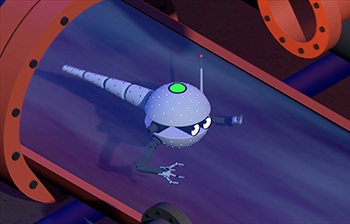Can you guess the amount of drinking water that gets wasted every day just because of leaks in pipes across the globe? As big a number as you may come up with, you’re probably still short. The estimated figure (and it’s a rough estimate) is 344.5 billion liters (91 billion gallons) — which means every minute about 239 million liters of clean water is wasted. This much water can quench the thirst of millions of households, alleviating the growing problem that is water availability.
Thanks to a team of engineers, there may be an unexpected way to fix it.
The power of AI pipebots
For obvious reasons, we can’t send humans inside all the pipes to fix leaks. But miniature robots could work; in fact, they may be our best bet if we want to fix leaks from the inside out.
A team of researchers at the Integrated Civil and Infrastructure Research Centre (ICAIR) in the UK is testing AI-powered miniature robots that can patrol inside water pipes, check for leaks, and repair them. These high-tech robots are called “pipebots” and while they look like small toy cars, come equipped with cameras, and have special legs that enable them to walk through any surface.
The engineers at ICAIR reveal that in many places, people have already started to employ tethered robots to clean and repair water pipes. However, none of those solutions comes close to the pipebots when it comes to intelligence and feasibility.
Pipebots can freely patrol inside pipes and use their microphone and camera they can listen to the pipes and detect any damages or leaks. Then, using AI, they can analyze a pipe problem and come up with the best solution to deal with it. Moreover, on the basis of the data they collect during patrolling, they can also predict if a pipe needs some repair or service in the near future.
One of the researchers and the professor of acoustics at the University of Sheffield, Professor Kirill V Horoshenkov told BBC:
“We need to have the presence of robots so they can continuously collect data before the onset of faults. They (pipebots) move along the pipe, taking pictures and they have a microphone to listen to the pipe. They’re designed to make decisions about whether the pipe is likely to develop a fault or not.”
Pipebots are still a work in progress
Despite being such a promising technology, scientists at ICAIR can not employ an army of pipebots right away in water pipes because there are still some challenges that they need to overcome. For instance, technologies like GPS don’t work inside the pipes so then how a pipebot will navigate through a complex pipe network?
Even if we upload a blueprint of a pipe network inside the robot’s system, then another issue is how the robots will communicate with one another. How will they come together to perform a complex repairing task that may require more than one pipebot. The engineers at ICAIR are already working on these problems.
For communication, they are considering short-range sound or wi-fi signals. For easy operability, they look forward to developing a mother robot that will keep all other miniature robots in control inside a pipe. There are many other ideas at work that aims at making a sustainable pipebot society inside our underground water pipes possible.
This is why it will take about four to five years before pipebots start patrolling and repairing water pipes. Still, while it won’t happen tomorrow, these miniature robots represent a groundbreaking technology that can save billions of gallons of clean water every day.
Once these robots are deployed in the water pipes, we will no longer need to drill, dig, and sent human labor to inhospitable environments just for fixing a leaking pipe. The researchers believe that similar robots might also protect and take care of our gas and oil pipelines and even underground cables.
While it may be a while before these robots actually start working, they seem like a promising technology and not a pipe dream. They can save a lot of time and water across the globe — and with climate change kicking more than ever, we absolutely need it.







